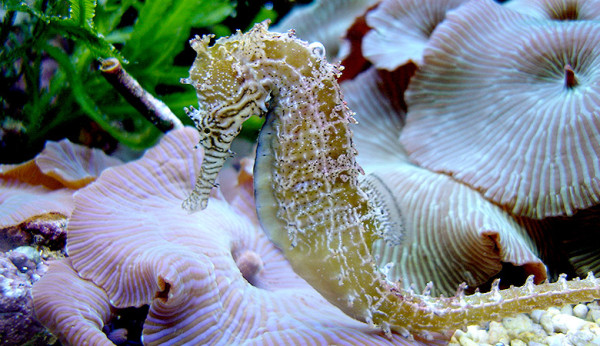The Barbour’s Seahorse, Hippocampus barbouri, is born a striking yellow with an eye catching zebra striped snout. Its textured skin with spines protruding from its body make it an unusual species.

Like most seahorses, it likes to hang out in intertidal zones amongst seagrass beds and mangrove roots. This seahorse is indigenous to the indo-pacific and can be found along the coasts of Indonesia, Malaysia, and the Philippines.
The majority of seahorses adapt to their surroundings and change color with their mood; however, the Barbour’s seahorse is naturally yellow and only changes shades between pale yellow and yellowish brown.

Because they occur in shallow water, the Barbour’s seahorse can be kept at a normal reef tank temperature. It may be housed with a few corals, particularly soft corals, but I would stay away from stinging corals or ones that require a strong current.The recommended aquarium size for a pair of Barbour’s seahorses is 20 to 30 gallons. Be sure to cover all pump intakes as they may get sucked against them and not be able to free themselves.
Other seahorses of the same species are the ideal tank mates but they may also be housed with pipefish, gobies, dartfish, blennies, and of course other seahorses. Crustaceans usually do not bother the seahorse but the Barbour’s seahorse may try to eat small shrimp or hermit crabs.

Captive bred seahorses will have a higher life expectancy than wild caught ones. Wild caught seahorses most often come in malnourished and carry diseases while captive bred seahorses are already trained to eat frozen food.
Additionally, you can train your seahorse to eat from a feeding station. The seahorse will readily come to the feeding station to eat once it knows your feeding schedule.
This seahorse has a smaller brood compared to the plentiful brood of H. reidi, the longsnout Brazilian seahorse. Furthermore, the Barbour’s seahorse does not breed as often as other seahorse species.

Hippocampus barbouri is an exceptional seahorse that is sure to enhance your aquarium. Its brilliant yellow color and zebra snout sets it apart from any other seahorse.



